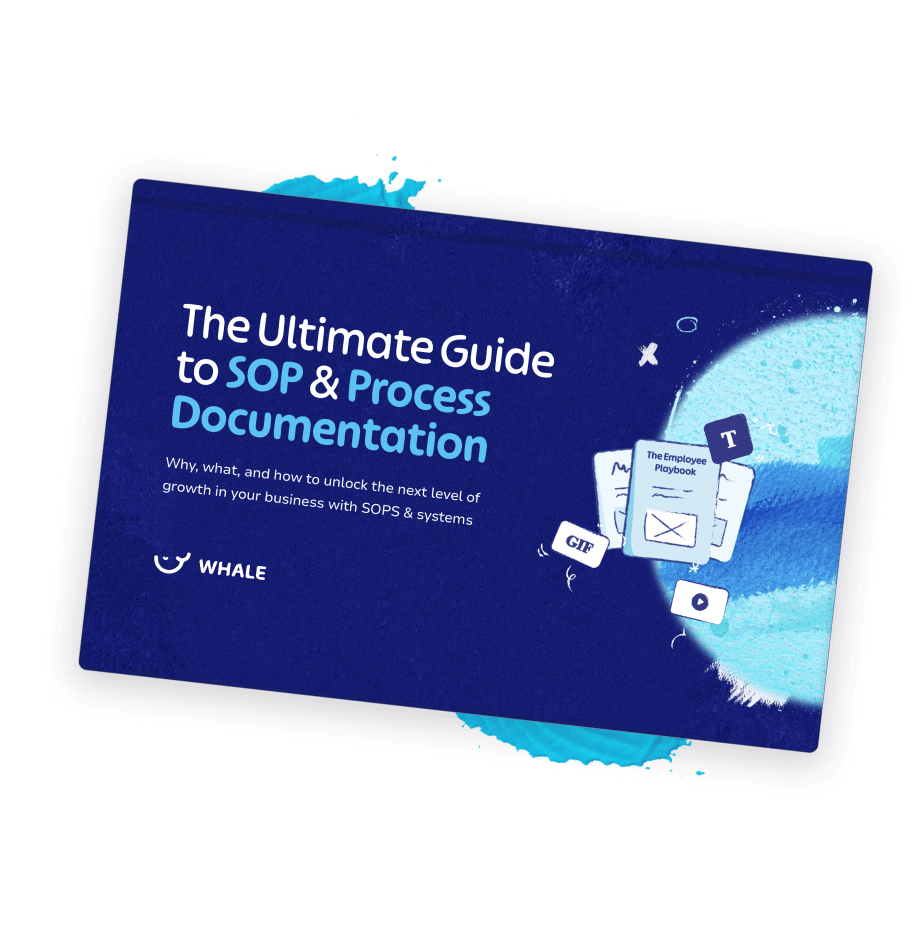Whether you’re just setting up your Standard Operating Procedures (SOPs), or your current documentation isn’t gaining enough airtime, getting SOP creation right can make all the difference.
Problem is, it’s harder than it sounds.
In fact, disorganized processes are one of the top 10 employee pain points, leading to around one-third of US employees looking for new roles. Not the kind of problem a growing business needs.
But what if you could create SOPs that help strengthen employee relationships, rather than break them? (Hint: You can.)
From digitizing processes to creating an SOP inventory, there are simple actions you can take to leave employees feeling more capable, productive, and secure in their roles.
So, how do you focus on great SOP creation from day one? What does a killer process look like? And how can you refresh outdated SOPs so they’re easier to use?
In this beginner’s guide to SOP creation, we’ll explain the ins and outs of processes that teams actually want to use, and show you how to create an SOP strategy to get you started.
Ready to boost productivity and save time with a smart SOP creation strategy? Get in touch for a free Whale demo today!
Let's talk SOP Creation🤔
Imagine a world where all your processes run in exactly the same format every. single. time. No matter who’s in charge, your employees know what to do and how to do it — and they enjoy the process.
Unfortunately, for many companies that perfect world is a long way off.
But by streamlining your SOP creation now, you can step closer to your ultimate goal (no matter where you currently are in your documentation journey).
7 Common challenges in creating standard operating procedures
Creating standard operating procedures (SOPs) is essential for ensuring consistency and efficiency in business operations. However, the process of creating these documents can be fraught with challenges.
Here’s a detailed look at some of the common issues organizations face when developing SOPs:
1. Identifying essential processes
Deciding which processes need SOPs can be tricky. Not all tasks require documented procedures, and over-documenting can be just as problematic as under-documenting.
Failing to identify key processes that need standardization can lead to inefficiencies and inconsistencies in how tasks are performed.
Use the 80-20 Rule to identify which are the most important SOPs to create first!
2. Gathering accurate information
Collecting comprehensive and accurate information about the processes can be difficult, especially in complex environments where multiple departments or roles are involved.
Incomplete or incorrect information can lead to ineffective SOPs that do not truly reflect the best practices or actual workflows.
3. Balancing detail and clarity
SOPs need to strike a balance between providing enough detail to guide the users and being clear and concise enough to be easily understood and followed.
Overly complex or overly simplified SOPs can result in non-compliance or errors in execution. Because who wants to read all of that?
4. Achieving buy-in
Getting all stakeholders to align to SOPs can be challenging. This includes the people who perform the tasks, those who manage them, and sometimes external parties.
Lack of buy-in can lead to poor adoption of the procedures, undermining the effectiveness of the SOPs.
5. Keeping processes updated
Keeping SOPs up-to-date with the latest regulations, technologies, and business practices is a continuous challenge. And outdated SOPs can lead to inconsistent delivery, non-compliance with laws and regulations, inefficiencies, and missed opportunities for improvement.
Make sure you review and update your SOPs quarterly or at least twice a year.
6. Training and implementation
Effectively training staff on new or revised SOPs and ensuring they are implemented correctly is critical.
Poor training can result in non-compliance with the SOPs and variations in how tasks are performed, inconsistencies and lack of improvement.
7. Measuring effectiveness
Determining the effectiveness of an SOP and understanding its impact on productivity and quality can be complex. Without effective measurement, it’s difficult to justify the need for SOPs or identify opportunities for improvement.
Why invest in a SOP creation strategy?
- Teams are more likely to use SOPs if you’ve made an effort: These days, rushing to jot down your procedures in a clunky word document just won’t cut it. If you make the effort to create SOPs that are fun to use, your teams will thank you for it.
- Save time in the long run: Okay, so building an SOP creation process will take time initially. But in the long run? You’re guaranteed to save time via automated processes and training opportunities.
- Boost employee engagement: With great procedures comes great job roles — and the more enjoyable your employees find their roles, the more likely they are to stick around for the long haul.
- Never lose knowledge: When employees leave, they take 42% of their role knowledge with them, leaving new hires having to relearn it all from scratch. Write the processes down before they leave, and the problem disappears.
- Spot opportunities for improvement: Putting SOPs into an easily accessible format will help you spot bottlenecks and areas for improvement. Simple.
- Keep updates minimal: If you take the time to create killer SOPs from day one, you’ll have less backtracking to do later — meaning minimal updates and maximum productivity.
Ready to create smart SOPs your employees will love? Get in touch for a free Whale demo today!
Top tips for creating great SOPs 💟
SOP creation tip: Go digital 🖥️
It’s official. The world’s gone digital — and to stay in the game, your company has to as well.
As millennial and Gen Z employees take over the workplace, they’re driving faster technology adoption — and these tech-savvy generations expect easy-to-access tools that make their lives (and jobs) easier.
When it comes to SOP creation, that means investing in a tool that leverages your documentation and makes it fun to use.
Use tech to prove your SOP credentials:
- Invest in a smart knowledge-sharing tool: If you want to ace your documentation journey, it’s time to seriously consider using a smart knowledge-sharing platform. The right tool will help manage all your documentation from one central hub and keep your employees involved every step of the way.
- Make documentation accessible: The days of 1000-page paper manuals are over. These days, documentation is all about engagement — so make sure your SOPs are bite-sized, accessible, and jargon-free with easy-to-use editing tools.
- Focus on visual SOPs: Your employees are used to being entertained at home, so why not entertain them at work too? Add images, videos, and gifs to your docs to keep employees interested at every turn.
Once you’ve chosen your ideal knowledge-sharing platform, it’s time to hone in on your SOP creation strategy.
From setting goals to making a process inventory, there are several key steps to creating a killer strategy that will make a tangible difference to your business.
Ready to create a strategy to get your teams excited about business processes?

How to create your SOP Strategy:
1. Set your goals
To get started with smart SOP creation, you need to set some realistic goals. Think about what you want to achieve by documenting your processes, why it’s important, and what the desired results are — and remember to cross-check them with your wider company goals for maximum impact.
Tip – Wondering if SOPs are important in your business? They are!
2. Identiify core processes
Once you know your goals, focus on one department at a time to pinpoint the core processes for each one. (Think: HR, marketing, sales, operations, accounting, and customer retention.)
3. Track key activities
Next, track all the activities your business runs in one week. If your company has any unused activities, add these at the end of your list and ask yourself why they weren’t used. This will highlight which are the most important and which can be dropped or simplified.
4. Get documenting
Now you’ve aced the legwork, it’s time to start documenting your processes. Start with rough drafts, add images and other details later, and use templates to create consistency across the board.
To create the BEST SOPs we suggest checking out;
- How to Start Documenting from Scratch
- SOP Writing Guidelines
5. Store processes in a centralized repository
Once you know your most (and least) important activities, it’s time to file them into a centralized process inventory or knowledge base.
Name each one, give it a brief description, check in with managers for accuracy, and delegate each process to an owner.
6. Share processes with your teams
Sharing is caring! Simply storing all your processes isn’t enough.
You need to make sure you’re sharing SOPs with your teams to gain maximum benefit. The best teams use technology to stay connected.
7. Measure progress
Business isn’t about creating SOPs and processes.
Business is about figuring out the best way to satisfy customers and offer a superior product or service. For that you need SOPs.
Once you’ve created your SOPs, make sure to keep measuring their ROI and impact on the business.

FAQs about SOP Creation
What are the main elements of an SOP?
Here’s a simplified list of the main elements of an SOP:
- Title: Clearly states the name or title of the SOP.
- Purpose/Objective: Clearly defines the purpose or objective of the SOP.
- Scope: Defines the boundaries and limitations of the SOP.
- Procedure: Presents the step-by-step instructions for carrying out the process or activity.
- Responsibilities: Identifies the roles and responsibilities of individuals or teams.
- References: Includes any relevant references or documents.
- Revision History: Documents changes or updates made to the SOP over time.
How should I format an SOP?
Formatting an SOP (Standard Operating Procedure) is crucial for clarity and ease of understanding. Here’s a recommended format:
-
Title Page:
- Title: Clearly state the name of the SOP.
- Version: Mention the version number and date of the SOP.
- Author: Name of the person or team who created the SOP.
- Approvals: List the names and signatures of those who have reviewed and approved the SOP.
-
Table of Contents:
- Include a detailed list of sections and subsections with corresponding page numbers for easy navigation.
-
Introduction:
- Provide an overview of the purpose and scope of the SOP.
- Explain why the SOP is necessary and its importance in the organization.
-
Objective:
- Clearly state the objective of the SOP.
- Describe what the SOP aims to achieve and its intended outcomes.
-
Scope:
- Define the boundaries and limitations of the SOP.
- Specify the departments, processes, or activities covered by the SOP.
-
Responsibilities:
- Identify the roles and responsibilities of individuals or teams involved in following the SOP.
- Clearly outline who is accountable for each step or task.
-
Procedure:
- Present the step-by-step instructions for carrying out the process or activity.
- Use clear and concise language.
- Include any necessary details, such as equipment, tools, or software required.
- Consider using visuals like flowcharts or diagrams to illustrate complex processes.
-
References:
- Include any references, documents, or regulations that the SOP is based on.
- Provide links or citations for additional reading or verification.
-
Glossary:
- Define any technical terms or acronyms used in the SOP to ensure clarity.
-
Appendices (if applicable):
- Include any supplementary materials, forms, templates, or examples that support the SOP.
-
Revision History:
- Document any changes or updates made to the SOP over time.
- Include the date of revision, a brief description of the changes, and the name of the person responsible for the revision.
Bottom line
Show employees you care with a smart SOP creation strategy
SOPs are the glue that holds a company together — which is why getting your SOP creation right should be top of every business leader’s agenda.
With the right approach and smart tools, you can help employees feel capable and productive from day one.
Show employees you care by giving them accessible, visual SOPs — and before you know it, they’ll be happier and more determined to work for your company than ever before.
Ready for a digital SOP strategy your teams will love?
Download our complimentary Ultimate Guide to SOP and Knowledge Management
Ultimate Guide to SOP & Process Documentation
The why, what, and how to unlock the next level of growth in your business with SOPS & systems








